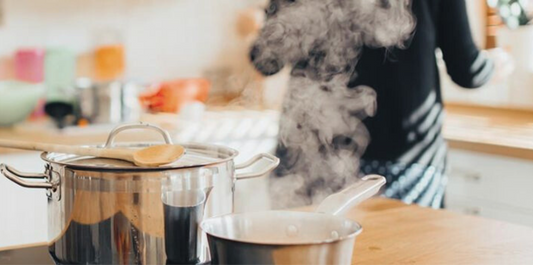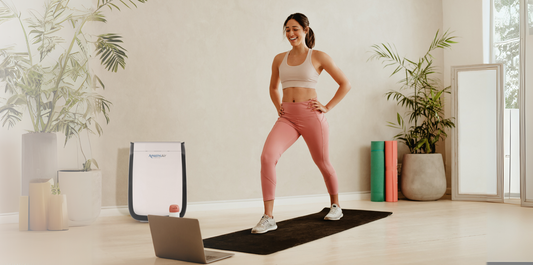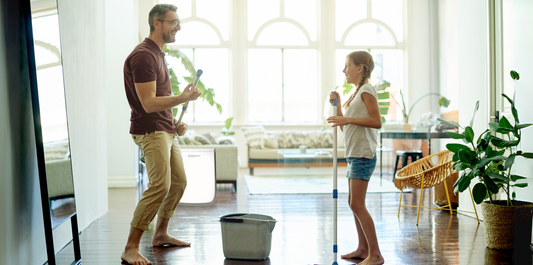Ever noticed how the smell of last night’s stir-fry still lingers in the morning? Cooking is part of everyday life, but it doesn’t just bring delicious meals. It also releases smoke, grease, and strong odours that can affect air quality throughout your home. In open-plan kitchens and smaller flats, these airborne pollutants don’t stay confined to the kitchen—they spread.
Opening a window or switching on the extractor fan can help, but it’s often not enough and can be dangerous, particularly in winter or in homes with poor ventilation. This is where an air purifier can make a noticeable difference.
What happens to air when you cook?
Cooking releases a mix of fine particles and gases into the air. Whether you’re frying, grilling, roasting or baking, common pollutants include:
- Fine particulate matter (PM2.5) – tiny particles that can penetrate deep into the lungs
- Volatile organic compounds (VOCs) – emitted from oils and ingredients, contributing to poor indoor air quality
-
Nitrogen dioxide (NO₂) – particularly from gas hobs, which can irritate the airways and impact respiratory health
According to the UK Government’s Clean Air Strategy 2019, cooking is one of the leading sources of indoor air pollution in UK homes. Everyday routines—like frying onions, searing meat or using cooking oils—can significantly increase pollutant levels indoors.
The impact on health and comfort
Household air pollution from cooking is more than just an inconvenience—it’s a serious health concern. The World Health Organization (WHO) reports that 3.2 million people die prematurely each year from illnesses linked to household air pollution, including exposure to particulate matter and harmful gases produced by cooking with solid fuels or kerosene.
These pollutants can inflame the lungs, reduce oxygen delivery in the body, and impair immune function. Long-term exposure has been linked to noncommunicable diseases such as ischaemic heart disease, stroke, chronic obstructive pulmonary disease (COPD), and lung cancer.
Children are especially vulnerable. Exposure to household air pollution almost doubles their risk of lower respiratory infections and is a factor in nearly half of all pneumonia-related deaths in children under five.
Even in the absence of visible health symptoms, indoor pollution affects comfort and quality of life. Lingering smoke, strong odours, and irritation to the eyes and throat can make your living environment less pleasant—particularly in enclosed or poorly ventilated spaces.
Why ventilation isn’t always enough
It’s easy to assume that opening a window or using the cooker hood will resolve the issue, but many homes—especially flats and rented properties—lack effective extraction systems. Others rely on recirculating fans that do little to remove fine particles or odours.
In colder months, or in areas where outdoor air is already polluted, opening windows may not be a viable option. Even well-installed ducted extractor fans are limited by maintenance and airflow efficiency, and they usually only operate during or immediately after cooking—leaving lingering particles behind.
How air purifiers help

Air purifiers with HEPA and activated carbon filters, such as AmazingAir, are designed to capture a wide range of indoor pollutants caused by cooking.
- HEPA filters trap fine particles like PM2.5
-
Activated carbon filters neutralise odours and absorb VOCs
Studies show that using air purifiers in residential kitchens can significantly reduce PM2.5 levels, improving air quality even in homes with gas appliances.
Unlike extractor fans, air purifiers can run quietly in the background throughout the day. They help maintain clean air not only during cooking but afterwards too. This is especially beneficial in households with children, pets, or individuals with asthma or other respiratory sensitivities.
Practical tips for cleaner kitchen air

- Run your air purifier during cooking and leave it on for a short time afterwards
- Place the purifier near the kitchen (but not directly next to the hob) to maximise airflow and safety
- Choose a model that includes both HEPA and carbon filters for comprehensive air cleaning
- Clean or replace filters regularly, following the manufacturer’s recommendations
- Combine air purification with good habits, such as wiping down surfaces and covering pans with lids while cooking
Cooking brings warmth and flavour to your home but it also affects the air you breathe. Ventilation plays a role, but in many homes it’s not enough. A high-quality air purifier offers a practical, effective solution to reduce kitchen smoke and odours and support a cleaner indoor environment.
In homes with open layouts or frequent cooking, clean air isn’t just a bonus—it’s essential for your health and wellbeing.





